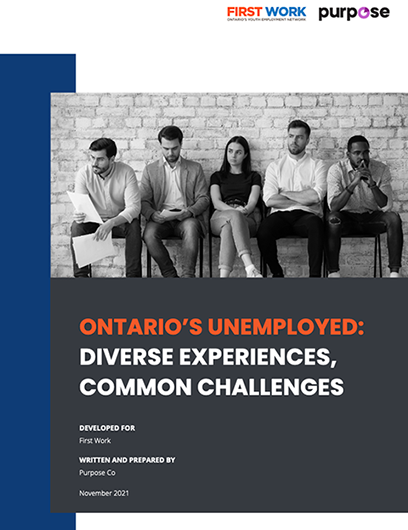First Work’s Job Seeker Research | Ontario’s Unemployed: Diverse Experiences, Common Challenges
This report focuses on NEET youth, long term unemployed, laid off workers because the challenges these individuals face are severe and near impossible to correct without proper interventions and holistic support.
The research conducted and experiences of these job seekers illustrate a vicious cycle often rooted in a disconnect in the experience and skills being sought in the labour market. These experiences are exacerbated by the experience of poverty and the longer a person remains unemployed, as well as by systemic and structural issues that marginalize people due to racism, immigration status, disability, sexual orientation, among other factors.
Both businesses and people need solutions that will work for them today, necessitating tight feedback loops in the workforce system that can effectively plan and prepare people for in-demand skills and jobs, while also addressing challenges exacerbated by the experience of poverty and unemployment.
Ontario’s Unemployed | Background
In early 2021, First Work undertook primary research to document the experiences and opinions of job seekers to better identify gaps and barriers in the current supports system, to help inform bridges needed to enhance employment success. Thanks to funding from JP Morgan & Chase, First Work undertook this research to better understand how to reach this ‘missing labour’ from Ontario’s workforce.
Diverse Experiences
NEET Youth
- Youth who have difficulties transitioning to the labour market otherwise known as NEET – not engaged in employed, education or training.
- NEET status can be indicative of significant barriers and is associated with an increased risk of low economic and social challenges
- Ontario’s pre-pandemic (2017-2019) trends indicated an overall decrease of 3.4% in NEET rate. In contrast, NEET rates in Ontario increased by 41% from 14.1% in 2019 to 19.9% in 2020 (StatCan, 2020a).
Displaced workers
- Laid-off, displaced or dislocated workers (LOW) are individuals currently not employed who last worked within the previous year and left that job involuntarily (employer-initiated job termination because of business conditions, downsizing, etc.).
- The pandemic resulted in unprecedented levels of lay-offs across the board, and youth workers between the ages 15-29 experienced the worst of it (+277% between 2019-2020).
Long-term unemployed
- Long-term unemployed are individuals who are actively looking for work but have not been employed for over 27 consecutive weeks (more than 6 months) (StatCan, 2021b).
- This group is of particular concern to policymakers as increases in the rates of long-term unemployed are an indicator of inefficient labour markets.
Common Challenges
Unemployment is a major life event that can have profound, long-lasting impacts on individuals, their families and communities. Periods of unemployment are associated with increased risks of poverty, social stigma, social isolation, mental health challenges, erosion of confidence and self-esteem, and the atrophying of work skills.
Amplified by pandemic impact, participants reported the following common challenges related to employability:
- Lack of recognized work experience that is perceived as competitive
- Limited professional networks and social capital
- Mismatch between their skills, qualifications, and experience employers require.
- Limited experience in effectively participating in a job search process
- Heightened needs related to mental health challenges
- Experiences with poverty, stigma, and discrimination
Report Recommendations
With the current labour shortage, Ontario’s pandemic recovery and long-term economic stability could see more success prioritizing the engagement of these groups in Ontario’s work force by developing, strengthening, and diversifying strategies to support these groups.
Report recommendations include holistic support with interventions that address these challenges in unity, taking into account mental and social factors to support a successful transition into sustainable employment.

